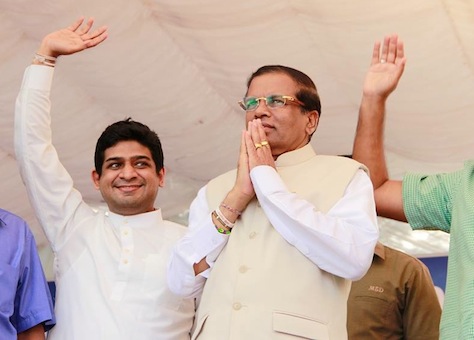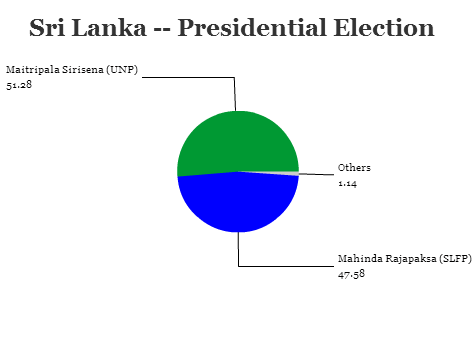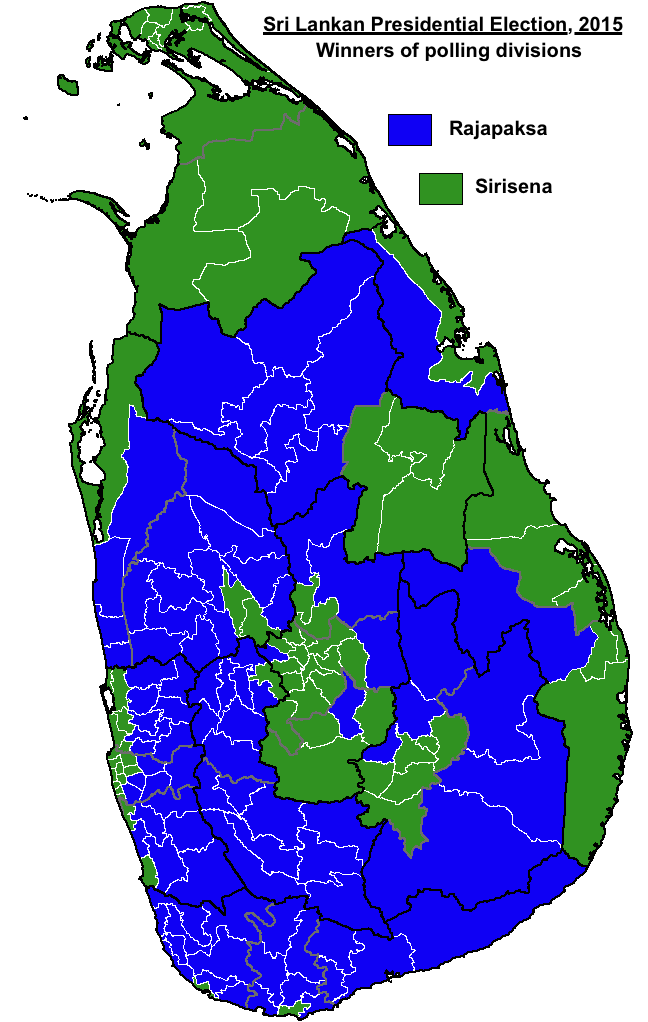
Sri Lanka has avoided all the dark warnings of coups and political tumult — for the time being.![]()
Former health minister and one-time ally Maitripala Sirisena easily defeated two-term incumbent Mahinda Rajapaksa, who called a presidential election two years early. Hoping to take advantage of a scattered opposition, Rajapaksa believed he would slide to an easy reelection to a third six-year term. Instead, Sirisena, the general secretary of Rajapaksa’s own party, the Sri Lanka Freedom Party (SLFP, ශ්රී ලංකා නිදහස් පක්ෂය), promptly resigned as Rajapaksa’s minister and led 25 SLFP members of the Sri Lankan parliament into the opposition coalition, upending what Rajapaksa thought would be a cakewalk.
Despite the fact that, like Rajapaksa, Sirisena comes from the country’s Sinhalese majority and practices Buddhism, he won significant support from Tamil-speaking Moors (who practice Islam) and Tamils (who practice Hinduism). That, in tandem with the support of a significant set of elites and Sinhalese voters who had soured on Rajapaksa’s decade-long rule, was enough to deliver to him 51.28% of the vote, versus just 47.58% for Rajapaksa.
In the space of six weeks, Sirisena has gone from the general secretary of the SLFP and top minister in the Rajapksa government to the president-elect and head of the titular coalition led by the opposition United National Party (UNP, එක්සත් ජාතික පක්ෂය), which traditional draws more support from Tamil-speaking minorities and which also embraces a more free-market liberal and center-right ideological persuasion.
* * * * *
RELATED: Tumultuous election a test for Sri Lankan democracy
* * * * *
Despite ominous warnings that Rajapaksa would deploy the military if he lost the election, the incumbent stepped down and moved out of the presidential palace, Temple Trees, immediately, paving the way for what could be a surprisingly easy and peaceful transfer of power for a country where elections and politics often collide in violence.
While Sirisena is the clearest winner of Thursday’s vote, Indian prime minister Narendra Modi is nearly as much of a winner. That’s because Sirisena is expected to strengthen ties with India at the expense of the People’s Republic of China. Increasingly, Rajapaksa looked to Beijing, not New Delhi, for international support, including billions in soft loans from the Chinese government, which in turn looked to Sri Lanka as its foothold in south Asia and the Indian Ocean. No longer. Sirisena has pledged to cancel several Chinese development projects that had become increasingly controversial.
Though Tamil Nadu, the state in southeast India closest to Sri Lanka, has long shared solidarity with the Tamils of Sri Lanka, and though the Tamil Nadu-based AIADMK (All India Anna Dravida Munnetra Kazhagam) controls the state government and virtually all of the state’s seats in the Indian parliament, Modi has pursued a relatively pramatic approach to Sri Lanka, inviting Rajapaksa to attend his swearing-in lat May, for example, to the annoyance of AIADMK leader (and, until recent legal troubles, chief minister) Jayalalithaa.
If the direction of Sri Lanka’s foreign policy is immediately clear, however, its domestic policy is not.
During Rajapaksa’s first term, the Sri Lankan military defeated once and for all the Liberation Tigers of Tamil Eelam (தமிழீழ விடுதலைப் புலிகள்), popularly known as the ‘Tamil Tigers,’ ending their 26-year campaign for Tamil independence. He also presided over significant GDP growth — nearly 7% a year. But rising Buddhist nationalism worried the country’s Tamil minority (together with Tamils of Indian descent, around 15% of the population) as well as its Moorish minority (another 10%). Sirisena’s chief priority should be to facilitate Sri Lanka’s transition from civil war to a country where all of its minorities flourish — and that’s one reason why Sirisena received such enthusiastic support from minorities.
Here’s a map of the polling divisions. What stands out is that Sirisena won chiefly those areas, such as the central highlands and the northern and western coasts, where the Tamil-speaking community thrives. Rajapaksa chiefly won the Sinhalese-speaking heartland.
In the meanwhile, Sirisena has pledged to call new parliamentary elections within 100 days. That’s a smart move, considering the SLFP-led coalition controls 144 out of 225 seats in the current parliament, while the UNP-led coalition controls only 60.
But the organizing principle of Sirisena’s disparate coalition, which includes Marxists alongside free-market champions and parts of the Sinhalese political elite alongside former Tamil rebels, was its passion for defeating Rajapaksa. Despite the tangible gains of his administration, he developed significant angst through his government’s alleged human rights abuses, anti-Tamil sentiment, restrictions on press freedom and, above all, widespread corruption and nepotism. Sirisena has pledged to change all of that, but holding together such a schizophrenic governing coalition will required lots of political compromises and, probably quite a bit of efficient corruption here and there, no matter what he said during the campaign. Transparency International ranks Sri Lanka 85th (tied with India, in fact) in its 2014 Corruption Perceptions Index.
Meanwhile, the fresh parliamentary campaign gives Rajapaksa a chance to retain at least some power to set Sri Lanka’s agenda. If his Freedom Party retains control of the Sri Lankan parliament, he might wind up with even more power in the Sirisena era if, as promised, Sirisena rebalances power away from the presidency, consolidated over the Rajapaksa era, and back to the parliament. The move from Westminster-style parliamentary democracy began,, however, under Rajapaksa’s predecessor, Chandrika Kumaratunga, who supported Sirisena in Thursday’s vote.
It comes as Sirisena will face calls to restore an independent judiciary and the rule of law, with renewed calls from Sri Lankan Tamils for a war crimes tribunal.
Though Sirisena has pulled, just eight days into the new year, one of 2015’s most fascination electoral upsets, the road ahead for him and for Sri Lanka won’t be easy.

